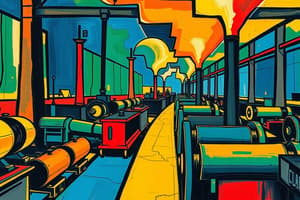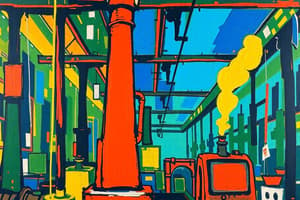Podcast
Questions and Answers
Who was Eli Whitney?
Who was Eli Whitney?
Eli Whitney was a scientist who made the first musket of interchangeable parts. His invention was significant because it allowed for the mass production of tools by unskilled workers.
Interchangeable parts are parts that can be used only once.
Interchangeable parts are parts that can be used only once.
False (B)
What is mass production?
What is mass production?
Mass production is the production of goods in large quantities.
What was the Industrial Revolution?
What was the Industrial Revolution?
What was the purpose of the Cotton Gin?
What was the purpose of the Cotton Gin?
Who was Henry Clay?
Who was Henry Clay?
What was the American System?
What was the American System?
What was the National Road?
What was the National Road?
What was the Erie Canal?
What was the Erie Canal?
What was the Tariff of 1816?
What was the Tariff of 1816?
What is nationalism?
What is nationalism?
What was the Adams-Onis Treaty?
What was the Adams-Onis Treaty?
What was the Monroe Doctrine?
What was the Monroe Doctrine?
What was the Missouri Compromise?
What was the Missouri Compromise?
Who was Andrew Jackson?
Who was Andrew Jackson?
What is the spoils system?
What is the spoils system?
What was the Indian Removal Act?
What was the Indian Removal Act?
What was the Trail of Tears?
What was the Trail of Tears?
What was the Tariff of Abominations?
What was the Tariff of Abominations?
What was the Bank of the United States?
What was the Bank of the United States?
What was the Panic of 1837?
What was the Panic of 1837?
What effects did the Embargo of 1807 and the War of 1812 have on Americans involved in shipping and foreign trade?
What effects did the Embargo of 1807 and the War of 1812 have on Americans involved in shipping and foreign trade?
How did manufacturing develop in New England?
How did manufacturing develop in New England?
Why was slavery abolished in the North?
Why was slavery abolished in the North?
How were the agricultural systems of the North and South different?
How were the agricultural systems of the North and South different?
How does agriculture in the North and South differ?
How does agriculture in the North and South differ?
How does manufacturing in the North and South differ?
How does manufacturing in the North and South differ?
What shifts in population might be attributed to advances in technology and changes in regional economies during America's Industrial Revolution?
What shifts in population might be attributed to advances in technology and changes in regional economies during America's Industrial Revolution?
What short and long term goals might President Monroe have had in mind when he formulated the Monroe Doctrine in 1823?
What short and long term goals might President Monroe have had in mind when he formulated the Monroe Doctrine in 1823?
What agreements did Congress reach that are regarded collectively as the Missouri Compromise?
What agreements did Congress reach that are regarded collectively as the Missouri Compromise?
From what you know about the Missouri Compromise and the controversy that preceded it, do you think the new spirit of nationalism in the US was strong or fragile? Why?
From what you know about the Missouri Compromise and the controversy that preceded it, do you think the new spirit of nationalism in the US was strong or fragile? Why?
How might reducing the property requirements for voting affect political campaigns?
How might reducing the property requirements for voting affect political campaigns?
Why did Jackson think that Native Americans should be moved west of the Mississippi?
Why did Jackson think that Native Americans should be moved west of the Mississippi?
How did the Cherokee react to the Indian Removal Act?
How did the Cherokee react to the Indian Removal Act?
In what ways do you think the Tariff crisis of 1828 and 1832 might be considered important milestones in American history before the Civil War?
In what ways do you think the Tariff crisis of 1828 and 1832 might be considered important milestones in American history before the Civil War?
Flashcards
Eli Whitney
Eli Whitney
A scientist who made the first musket of interchangeable parts. He is important because he made the first steps of developing tools that unskilled workers could make in abundance.
Interchangeable parts
Interchangeable parts
Parts that can be used again and again.
Mass production
Mass production
The production of goods in large quantities.
Industrial Revolution
Industrial Revolution
Signup and view all the flashcards
Cotton Gin
Cotton Gin
Signup and view all the flashcards
Henry Clay
Henry Clay
Signup and view all the flashcards
American System
American System
Signup and view all the flashcards
National Road
National Road
Signup and view all the flashcards
Erie Canal
Erie Canal
Signup and view all the flashcards
Tariff of 1816
Tariff of 1816
Signup and view all the flashcards
Nationalism
Nationalism
Signup and view all the flashcards
Adams-Onis Treaty
Adams-Onis Treaty
Signup and view all the flashcards
Monroe Doctrine
Monroe Doctrine
Signup and view all the flashcards
Missouri Compromise
Missouri Compromise
Signup and view all the flashcards
Andrew Jackson
Andrew Jackson
Signup and view all the flashcards
Spoils system
Spoils system
Signup and view all the flashcards
Indian Removal Act
Indian Removal Act
Signup and view all the flashcards
Trail of Tears
Trail of Tears
Signup and view all the flashcards
Tariff of Abominations
Tariff of Abominations
Signup and view all the flashcards
Bank of United States
Bank of United States
Signup and view all the flashcards
Panic of 1837
Panic of 1837
Signup and view all the flashcards
Effects of the Embargo of 1807 & the War of 1812
Effects of the Embargo of 1807 & the War of 1812
Signup and view all the flashcards
Industrial Development in New England
Industrial Development in New England
Signup and view all the flashcards
Abolition of Slavery in the North
Abolition of Slavery in the North
Signup and view all the flashcards
Agricultural Systems: North vs. South
Agricultural Systems: North vs. South
Signup and view all the flashcards
Agriculture: North vs. South
Agriculture: North vs. South
Signup and view all the flashcards
Manufacturing: North vs. South
Manufacturing: North vs. South
Signup and view all the flashcards
Population Shifts in the Industrial Revolution
Population Shifts in the Industrial Revolution
Signup and view all the flashcards
Monroe Doctrine
Monroe Doctrine
Signup and view all the flashcards
Monroe Doctrine: Short and Long Term
Monroe Doctrine: Short and Long Term
Signup and view all the flashcards
Missouri Compromise
Missouri Compromise
Signup and view all the flashcards
Nationalism: Fragile or Strong
Nationalism: Fragile or Strong
Signup and view all the flashcards
Voting Requirements: Impact On Campaigns
Voting Requirements: Impact On Campaigns
Signup and view all the flashcards
Jackson's Beliefs About Native Americans
Jackson's Beliefs About Native Americans
Signup and view all the flashcards
Cherokee Resistance to Removal
Cherokee Resistance to Removal
Signup and view all the flashcards
Tariff of Abominations: Milestone?
Tariff of Abominations: Milestone?
Signup and view all the flashcards
Study Notes
Eli Whitney
- Invented the first musket of interchangeable parts
- Pioneered tools for mass production by unskilled workers
Interchangeable Parts
- Parts that can be repeatedly used
Mass Production
- Production of goods in large quantities
Industrial Revolution
- Social and economic shift from hand tools to large factory production
Cotton Gin
- Machine that made short-staple cotton profitable
Henry Clay
- House Speaker who promoted the American System
American System
- Plan by President Madison to unite and strengthen the U.S. economy
- Included developing transportation, a protective tariff, and a national bank
National Road
- Federally funded highway connecting regions
Erie Canal
- 363-mile canal connecting the Hudson River to Lake Erie
Tariff of 1816
- Tariff to pay for internal improvements, upsetting some Southerners and Westerners
Nationalism
- Prioritizing national interests over regional ones
Adams-Onís Treaty
- Spain ceded Florida and Oregon claims to the U.S.
Monroe Doctrine
- U.S. foreign policy statement
- Distinct spheres of influence for Americas and Europe
- No European colonization in the Western Hemisphere
- U.S. non-interference in European affairs
- European interference in the Western Hemisphere is seen as hostile
Missouri Compromise
- Temporary solution to the slavery crisis
Andrew Jackson
- Won popular vote but lost electoral college to John Quincy Adams; supporters formed the Democratic-Republican Party
Spoils System
- Replacing government officials with supporters
Indian Removal Act
- Forced Native American relocation west of the Mississippi
Trail of Tears
- Forced march of the Cherokee, causing many deaths
Tariff of Abominations
- High tariffs causing the South to buy more expensive Northern goods
Bank of the United States
- Andrew Jackson's opposition and veto of the recharter
Panic of 1837
- Bank closures and credit collapse causing widespread economic hardship
Embargo of 1807 and War of 1812 Effects on Shipping
- Trade disruptions led Americans to invest in other ventures
New England Manufacturing Development
- Dependence on shipping and foreign trade led to textile factory development
Abolition of Slavery in the North
- Lack of economic need and moral opposition
Northern and Southern Agricultural Differences
- South's favorable climate for agriculture; North's short growing season
Northern and Southern Manufacturing Differences
- North manufacturing goods for South and West; South providing grain, meat, and cotton
Population Shifts Due to Industrialization
- Industrialization attracted people to cities for new job opportunities in factories
Monroe Doctrine Purpose
- Avoid conflict, protect trade, and deter European colonization attempts
Missouri Compromise Agreements
- Missouri as a slave state, Maine as a free state, no slavery north of the Louisiana Purchase
Nationalism's Fragility During Missouri Compromise
- The compromise caused deep divisions, highlighting fragile nationalism
Property Requirements for Voting
- Lowering property requirements expanded voting rights, potentially changing campaign strategies
Jackson's Reasons for Indian Removal
- Native Americans' failure to adapt to American culture, desire for land, and perceived non-profitability
Cherokee Reaction to Indian Removal Act
- Resistance, attempts to gain fair treatment, and legal challenges
1828 and 1832 Tariffs as Milestones
- Created a larger North-South divide, highlighted state versus national rights, and nearly led to Southern secession.
Studying That Suits You
Use AI to generate personalized quizzes and flashcards to suit your learning preferences.




